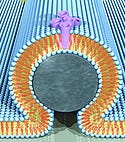October 5, 2009
Originally Published MPMN October 2009
NEED TO KNOW
Membrane-Encased Nanowires May Help Prosthetic Devices Talk to the Body
|
The nanowire and lipid configuration is a representational image of a vertical nanowire. |
Many prosthetic devices incorporate microelectronics and robotic components, but they cannot accurately mimic the motions of actual limbs. For example, current prosthetic devices do not provide feedback to the wearer or adjust to variable loads or complex terrains. To address this problem, scientists at the Lawrence Livermore National Laboratory (LLNL; Livermore, CA; www.llnl.gov) have developed a technique that enables nanowires to function like nerve cells, opening the door to improved communication between prosthetic devices and the body.
Aleksandr Noy, a chemist in LLNL’s biosciences and biotechnology division, and graduate students Nipun Misra and Julio Martinez, have developed a means for encasing nanowires in a fatty membrane—a step toward improving bioelectronic devices. While bare nanowire transistors exhibit a measurable change in electrical properties when they are exposed to acidic or basic solutions, the membrane-sealed nanowires do not react to their environment because the fatty layer protects them, just like a biological cell membrane. “Nanowires are sensitive to pH, and we want to use that sensitivity to read the signals that we are interested in,” Noy remarks. “So, it was important for us to insulate the wires from the solution they’re placed in. This is what the lipid bilayer does; without it, the device would react to all pH changes all the time.”
The device consists of arrays of silicon nanowire transistors—rows of 30-nm-diameter wires bound at either end by electrical contacts—that are placed in a microfluidic device. The microfluidics deliver hollow spheres of fatty membrane molecules, which are attracted to the negatively charged surfaces of the nanowires. As they accumulate, the fatty molecules fuse together to form a continuous membrane that seals the wires, just as a biological membrane seals the contents of a cell. “We first make lipid vesicles—tiny hollow spheres of a lipid bilayer—and then fuse them on the device surface to create a lipid blanket over it,” Noy explains.
To make the nanowires responsive to the surrounding chemical environment, Noy’s team added proteins to form ion channels, which control the flow of charged atoms and molecules across cell membranes. By using the nanowires to create a voltage difference across the membrane, the voltage-responsive protein can be opened and closed, allowing the nanowires to turn their chemical-sensing ability on or off. The nanowires create a voltage difference by acting as an electrode. Since they are connected to the rest of the device using microfabricated metal lines, they can be biased using an external power source. “The idea was to shield the nanowire with the lipid shell and then put a ‘gate’ in that shell to transmit a useful signal. That gate is the membrane protein channel,” Noy says.
When put into solution with the nanowires, the proteins insert themselves into the membrane, where they can mimic nerve-cell electrical signals. “The mimicking part has to do with the idea that an electrical impulse can open and close the ion channels in the membrane and trigger the ion flow,” according to Noy. “Of course, real nerve cells do this not with protons but with sodium and potassium ions, and they do it in a much more elegant and complicated way. However, I think of our work as a start.”
On a very local level—for example, in a nerve junction—this kind of nanowire device could help to read chemical signals generated by the body and then translate them into electric signals that can drive a prosthetic device, according to Noy. “We are trying to create a much tighter interface between the body control system and the prosthetic control system.”
In addition to finding its way into future prosthetic limbs, Noy’s breakthrough may also be used to make better interfaces for such devices as cochlear implants. “If you can make modern microelectronics talk to living organisms, you can make more-efficient prosthetics or new types of biosensors for medical diagnostics,” he remarks. “Right now, this work is in an early stage, so it will take time before anything resembling real medical device prototypes will emerge.” However, Noy thinks that this is an exciting direction that may lead to prosthetics and diagnostics that will connect with the human body more effectively than current devices do.
Copyright ©2009 Medical Product Manufacturing News
You May Also Like



